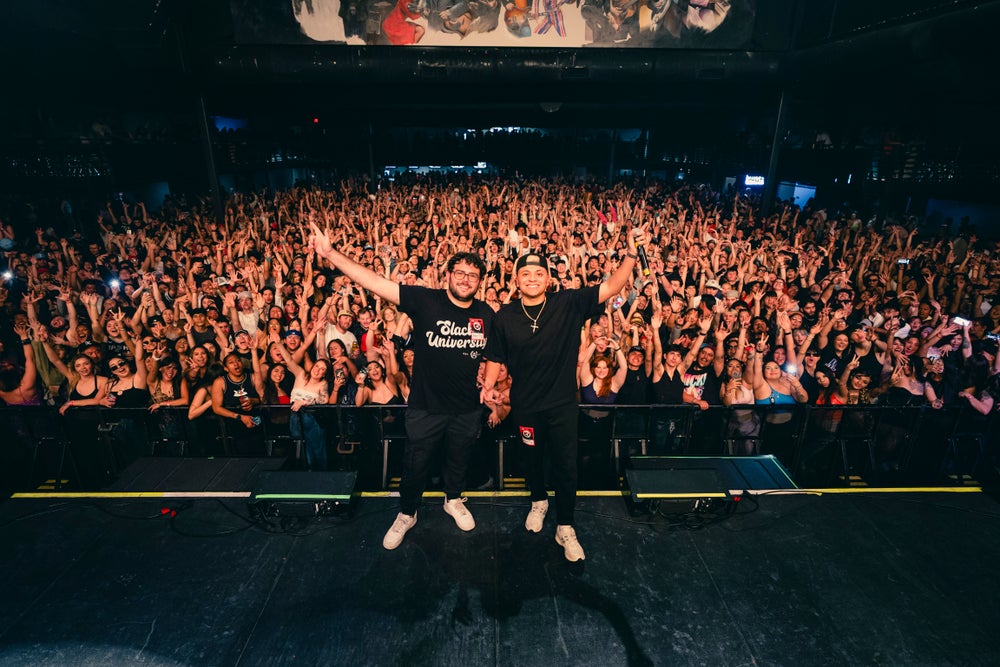This Side Hustle Spotlight Q&A features Ross Friedman, 26, of Boston, Massachusetts. Friedman is the founder of Slacker Media Group, a live events company curating experiences at the intersection of music, lifestyle and entertainment. See how he grew the venture from side hustle to successful full-time business, here. Responses have been edited for length and clarity.

Image Credit: Courtesy of Slacker Media Group. Ross Friedman.
Want to read more stories like this? Subscribe to Money Makers, our free newsletter packed with creative side hustle ideas and successful strategies. Sign up here.
What was your day job or primary occupation when you started your side hustle?
I started my business when I was in high school and continued to run it through college. During the early days of the business, I was a full-time student.
When did you start your side hustle, and where did you find the inspiration for it?
I started my business at the end of 2016 when I was 16 years old. I had been DJ-ing since I was 11 and wanted to find a space to play publicly and party with my friends. I did some research and found some companies that were running “Teen Nights” in other cities, but there were none in the Boston area. I decided I would start up my own, and the rest is history.
What were some of the first steps you took to get your side hustle off the ground? How much money/investment did it take to launch?
For my business, the first step was to find a venue. Unsurprisingly, not many nightclubs were willing to rent their club to a 16-year-old. After reaching out to almost every nightclub and event venue in the Boston area, I was finally able to lock down a date at the Middle East Downstairs in Cambridge, Massachusetts — albeit on a Monday night.
It took about $3,000 to rent the venue and market the event, which I had saved up from DJ-ing Bar Mitzvahs and proms. That first event brought in over 400 people, and I made about $3,000 in profit, which showed me that this could be a viable business.
Are there any free or paid resources that have been especially helpful for you in starting and running this business?
YouTube and Google are entrepreneurs’ best friends. Entrepreneurs need to be a Swiss army knife in many ways. Between those two platforms, if you’re passionate enough, you can learn anything for free.
That said, I do believe that college also played a big part in the success of my business. One professor in particular, Richard Sparacio, exposed me to a new way of thinking about business that fundamentally changed how I work. My professor assigned a book called The E-Myth by Michael E. Gerber that really spoke to me. The book talks about how many small business owners often try to do everything themselves within their business, and in doing that, they start working for the business instead of having the business work for them. The book focuses on the importance of setting up repeatable and teachable systems within your business in order to get out of that cycle. After reading the book and discussing it in class, I was able to take a step back from where I was with my own business and began to build out my own systems and processes that would lead to hiring my first full-time employee and scaling the business to our first $1 million year. Since that point, the growth of the business has been exponential.
Image Credit: Courtesy of Slacker Media Group
If you could go back in your business journey and change one process or approach, what would it be, and how do you wish you’d done it differently?
I really wish I had learned to hire earlier. I have always had a great team around me, from the early days to now, but for most of my career, I was the only person working on the project full-time. I made myself responsible for so much, and in the end, it limited the growth of the business. Learning to bring people in and to delegate tasks efficiently has changed my business and my life.
When it comes to this specific business, what is something you’ve found particularly challenging and/or surprising that people who get into this type of work should be prepared for, but likely aren’t?
Stress. The live events industry is an extremely challenging industry to be in; that, coupled with the inherent stress of entrepreneurship, can be too much for many people. Being able to manage the stress of running a business based on variables that I have no control over has been one of the biggest challenges of my career. Having worked on it for many years, though, learning the stress management skill is something that has benefited me immensely not only in my professional life but also in my personal life.
Can you recall a specific instance when something went very wrong? How did you fix it?
There are so many instances where things have gone horribly wrong, but the biggest for me and everyone else in the live events business was the pandemic shutdown. Before the shutdown, I was throwing college nights in Boston, still working out of the Middle East Downstairs. I had just locked in a weekly Thursday night residency and had put everything on the line to make it work. Then, the world shut down.
With in-person events off the table, I didn’t slow down — I just shifted gears. I threw myself into learning everything I could about social media, audience growth and brand-building. From what I learned about social media, I decided to launch the Slacker University network, which is a series of targeted Instagram pages mixing school-specific content with Slacker content. That network enabled me to have a built-in audience to target for events once the world opened up.
So, when events came back, I hit the ground running. That social network became the engine behind my first national tour — and we sold it out.
How long did it take you to see consistent monthly revenue? How much did the side hustle earn?
It took me years to see consistent revenue. The live events industry can be very volatile and carries a lot of financial risk, so pre-pandemic, there were years where I did great, and some years where I didn’t. Things really became profitable for me right after the pandemic, and in fall 2021, I made over $100,000 in only two and a half months.
What does growth and revenue look like now?
We are on track to do nearly $2.5 million in revenue across over 150 events this year, with over $1 million already generated year-to-date. Our lifetime sales are now over $4 million, and we’ve brought in over 250,000 attendees to our events.
How much time do you spend working on your business on a daily, weekly or monthly basis? How do you structure that time? What does a typical day or week of work look like for you?
As a start-up, solo entrepreneur, I was always “working” on my business. Since I was responsible for everything, I never really separated work from non-work. It was always on my mind, either in the front or in the back.
In the past year, I was finally able to bring on my first full-time employee, and I have now brought on a second full-time employee this year. Building the team around me has completely changed my life, and I’m now doing a healthier 40-hour work week on average. Of course, some weeks require more, but I am so lucky to have an amazing team that has allowed me to reclaim some of my time and make this business sustainable for the long run.
What do you enjoy most about running this business?
I gain personal happiness and joy from making others happy. This business has allowed me to do that at such a large scale, and it brings me immense joy to know that I am making hundreds of thousands of people’s lives just a little bit better. Nothing makes me happier than being on site at a successful event and seeing people smiling and having a great time.
What is your best piece of specific, actionable business advice?
Start a to-do list. Putting things in writing not only makes it easier to remember what needs to get done, but it actually forces you to think about what specific actions you are going to take. As basic as it is, a to-do list makes you organize your thoughts, motivates you to actually execute on your ideas and gives you a great sense of satisfaction when you can check something off your list.
This article is part of our ongoing Young Entrepreneur® series highlighting the stories, challenges and triumphs of being a young business owner.



